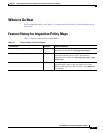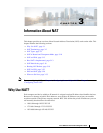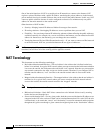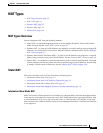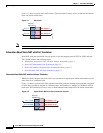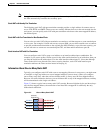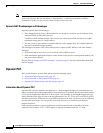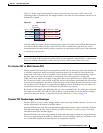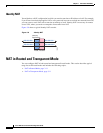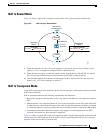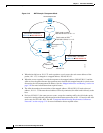
3-5
Cisco ASA Series Firewall CLI Configuration Guide
Chapter 3 Information About NAT
NAT Types
Note For applications that require application inspection for secondary channels (for example, FTP and VoIP),
the ASA automatically translates the secondary ports.
Static NAT with Identity Port Translation
The following static NAT with port translation example provides a single address for remote users to
access FTP, HTTP, and SMTP. These servers are actually different devices on the real network, but for
each server, you can specify static NAT with port translation rules that use the same mapped IP address,
but different ports.
Static NAT with Port Translation for Non-Standard Ports
You can also use static NAT with port translation to translate a well-known port to a non-standard port
or vice versa. For example, if inside web servers use port 8080, you can allow outside users to connect
to port 80, and then undo translation to the original port 8080. Similarly, to provide extra security, you
can tell web users to connect to non-standard port 6785, and then undo translation to port 80.
Static Interface NAT with Port Translation
You can configure static NAT to map a real address to an interface address/port combination. For
example, if you want to redirect Telnet access for the ASA outside interface to an inside host, then you
can map the inside host IP address/port 23 to the ASA interface address/port 23. (Note that although
Telnet to the ASA is not allowed to the lowest security interface, static NAT with interface port
translation redirects the Telnet session instead of denying it).
Information About One-to-Many Static NAT
Typically, you configure static NAT with a one-to-one mapping. However, in some cases, you might want
to configure a single real address to several mapped addresses (one-to-many). When you configure
one-to-many static NAT, when the real host initiates traffic, it always uses the first mapped address.
However, for traffic initiated to the host, you can initiate traffic to any of the mapped addresses, and they
will be untranslated to the single real address.
Figure 3-3 shows a typical one-to-many static NAT scenario. Because initiation by the real host always
uses the first mapped address, the translation of real host IP/1st mapped IP is technically the only
bidirectional translation.
Figure 3-3 One-to-Many Static NAT
10.1.2.27
10.1.2.27
10.1.2.27
209.165.201.3
Inside Outside
209.165.201.4
209.165.201.5
Security
Appliance
248771



